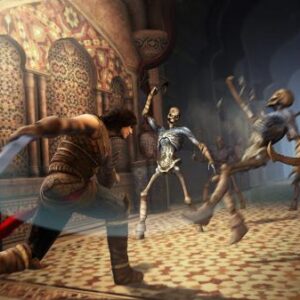Prince of Persia: The Forgotten Sands Free Download Direct Steam-Cracked
The Prince of Persia franchise has a rich, storied legacy that dates back to the late 1980s, making it one of the most iconic action-adventure series in gaming history. To truly appreciate The Forgotten Sands, we must look back at how far the series has come and how each era of development contributed to the title we celebrate today.
The Birth of the Prince – 1989
The original Prince of Persia was released in 1989 by Jordan Mechner, a visionary game developer who revolutionized animation in games using rotoscoping techniques. Its fluid movement and challenging puzzles set it apart from other side-scrolling platformers of the era. This version featured a nameless protagonist trying to rescue a princess within a strict time limit, setting the foundation for the saga’s emphasis on agility, timing, and high-stakes storytelling.
The 1990s: Sequels and 3D Experiments
Following the success of the original, Prince of Persia 2: The Shadow and the Flame was released in 1993, expanding on the storyline and increasing the complexity of environments and enemies. The shift to 3D came with Prince of Persia 3D in 1999, which attempted to modernize the franchise but was met with mixed reviews due to clunky controls and dated graphics.
Despite these missteps, the franchise remained relevant in gaming culture. Ubisoft’s eventual acquisition of the IP breathed new life into the series.
The Golden Age – The Sands Trilogy (2003–2005)
Ubisoft’s Prince of Persia: The Sands of Time (2003) marked a rebirth. It introduced time-reversal mechanics, fluid acrobatics, and a deeply emotional narrative. This game was a massive critical success and defined a new genre of action-adventure gameplay.
Its sequels, Warrior Within (2004) and The Two Thrones (2005), pushed the narrative in darker directions and introduced dual personalities, more brutal combat, and new parkour elements. This trilogy remains beloved by fans and is frequently cited as one of the best action game arcs in gaming history.
The Forgotten Sands: A Return to Form
Released in 2010, The Forgotten Sands sought to recapture the magic of the Sands Trilogy while integrating modern gameplay enhancements. It positioned itself narratively between The Sands of Time and Warrior Within, offering players a more complete view of the Prince’s transformation.
By blending classic mechanics with new elemental powers and delivering an epic, cinematic experience, The Forgotten Sands became a vital installment that satisfied long-time fans while appealing to new audiences.
Legacy and the Future
Although The Forgotten Sands didn’t spawn immediate sequels, it left an undeniable mark. Its influence can be seen in modern parkour-based games like Assassin’s Creed, another Ubisoft powerhouse. The ongoing development of the Prince of Persia: Sands of Time Remake also proves that interest in the franchise remains strong.
From humble beginnings in 2D platforming to cinematic 3D adventures, Prince of Persia has consistently set the bar for storytelling, animation, and immersive gameplay. The Forgotten Sands stands proudly among its predecessors, not only connecting the narrative but celebrating the franchise’s evolution.
25. Cultural Resonance: How Prince of Persia Influenced Pop Culture
Beyond the gaming sphere, Prince of Persia has had a significant cultural impact, influencing other media and becoming a recognizable name even outside core gaming audiences. From novels to comic books and even a major motion picture, the series has made notable strides in mainstream entertainment.
Hollywood Adaptation
In 2010, the same year The Forgotten Sands released, Prince of Persia: The Sands of Time hit the big screen as a live-action film starring Jake Gyllenhaal. While met with mixed reviews, it was one of the more successful video game adaptations of its time, grossing over $336 million worldwide. The film introduced the mythos of the Prince to an entirely new demographic and proved that the franchise had global appeal.
Influence on Other Games
The gameplay innovations from Prince of Persia—particularly time manipulation, fluid parkour, and cinematic presentation—influenced a wide array of action and platforming titles. Franchises such as Tomb Raider, Uncharted, and Assassin’s Creed (which shares many developers with PoP) borrowed heavily from its mechanics and design philosophy.
Cultural Symbolism
The series has often drawn from Persian mythology and Middle Eastern aesthetics, helping to bring these often-underrepresented themes into mainstream gaming. While sometimes critiqued for historical inaccuracies, the visual language and storytelling have nevertheless introduced global players to elements of ancient architecture, mysticism, and heroic archetypes.
Lasting Fan Engagement
Online forums, fan art, cosplay communities, and modding groups continue to thrive around the Prince of Persia franchise. The Forgotten Sands remains a staple in speedrunning communities and has even inspired academic discourse on narrative design in interactive media.
SYSTEM REQUIREMENTS
- OS *: Windows XP (SP3) / Windows Vista (SP2)
- Processor: 2.6 GHz dual-core Intel Pentium D
- Memory: 1 GB Windows XP / 2 GB Windows Vista (2 GB / 4 GB recommended)
- Graphics: 256 MB DirectX 9.0c–compliant card with Shader Model 3.0
- DirectX®: DirectX 9.0c
- HDD: 8 GB
Game Insights
- Genre: Action, Adventure
- Developer: Ubisoft Montreal
- Platform: PC
- Game Size: 5.2 GB
- Released By: SKIDROW emu | Ty csrin
- Version: v1.0 | Full Version
- Full PC Games


